Oviedo y Pueblo de Guzman: Wonderful Hosts and Sword Dancing from Afar
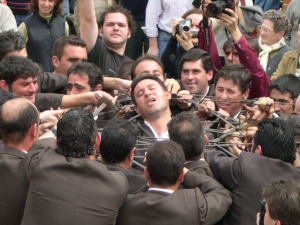 Ok, I’m just going to zip on through here! I went to Oviedo and met up with the leader of the dance group, who was also the town mayor and baker. We spent a lovely afternoon sharing our respective dances and trading videos, which was a lot of fun! Their dance is in many ways similar to the basque dances in formation, but the two or four lines that are formed are actually just one or two, with the dancers forming a zig-zag back and forth to give the impression of more lines.
Ok, I’m just going to zip on through here! I went to Oviedo and met up with the leader of the dance group, who was also the town mayor and baker. We spent a lovely afternoon sharing our respective dances and trading videos, which was a lot of fun! Their dance is in many ways similar to the basque dances in formation, but the two or four lines that are formed are actually just one or two, with the dancers forming a zig-zag back and forth to give the impression of more lines.
Since they do their dancing in early summer and midwinter I was unable to see the dance live, but I was able to watch and copy all the videos they had while asking tons of questions, as usual. They usually have 32 dancers as well as an unusually large band (matched in size possibly by Orion Longsword!) that includes guitars, accordions, mandolins, tamborines and used to have a fiddle.
The dance goes on for around 45 minutes, but happens several times throughout the Romaria of San Benito. If you have specific questions about the dance, please ask, but for right now I will let the photos tell most of the tale.

 That night I ended up staying a few doors down from the mayor with two brothers who had come to spain from Armenia (i believe) 10 years ago and were construction laborers. Their apartment was tiny and totally falling apart, but they could not have been more generous in sharing their food and conversation. We had a meet and rice stew and then talked about culture in our three collective countries of knowledge. We also watched some spanish TV, which helps me learn a lot, though the content could not have been more ridiculous. Well, I suppose it could have been US tv.
That night I ended up staying a few doors down from the mayor with two brothers who had come to spain from Armenia (i believe) 10 years ago and were construction laborers. Their apartment was tiny and totally falling apart, but they could not have been more generous in sharing their food and conversation. We had a meet and rice stew and then talked about culture in our three collective countries of knowledge. We also watched some spanish TV, which helps me learn a lot, though the content could not have been more ridiculous. Well, I suppose it could have been US tv.
 I got up super early after not enough sleep, and still was a little bit sick. I hate getting sick, partially because it happens so rarely that I sort of treat it as my body betraying me. Anyway, I got to the town center just as the bar was opening and got a sandwhich there for breakfast. Pretty soon the little van that served as the shuttle to Cerro Muriano picked me up and drove us in the semi-dark to the bus stop there, where i had a coffee and caught the bus the rest of the way back (although not before befriending the neighborhood pony and the dog it was friends with!) Once in Cordoba again, I got some real food and busked while waiting for my bus to huelva. It was a fairly hot day out so I ended up taking some breaks but managed to busk until 20 minutes before my bus before a security guard came out and said that I should move along. Actually, that I could only stay for another 15 minutes! Well, that was ok then, and I got on the bus and headed to the city of Huelva. The bus ride was several hours and I thankfully slept most of the way there. I we arrived a few minutes early which enabled me to do a frantic run over to the ticket machine and then to my next bus, which I wasn’t expecting to be able to make! This bus took me on a beautiful scenic drive through the hills of Huelva province. The landscape was stark, desert-like, and dotted everywhere with wind turbines.
I got up super early after not enough sleep, and still was a little bit sick. I hate getting sick, partially because it happens so rarely that I sort of treat it as my body betraying me. Anyway, I got to the town center just as the bar was opening and got a sandwhich there for breakfast. Pretty soon the little van that served as the shuttle to Cerro Muriano picked me up and drove us in the semi-dark to the bus stop there, where i had a coffee and caught the bus the rest of the way back (although not before befriending the neighborhood pony and the dog it was friends with!) Once in Cordoba again, I got some real food and busked while waiting for my bus to huelva. It was a fairly hot day out so I ended up taking some breaks but managed to busk until 20 minutes before my bus before a security guard came out and said that I should move along. Actually, that I could only stay for another 15 minutes! Well, that was ok then, and I got on the bus and headed to the city of Huelva. The bus ride was several hours and I thankfully slept most of the way there. I we arrived a few minutes early which enabled me to do a frantic run over to the ticket machine and then to my next bus, which I wasn’t expecting to be able to make! This bus took me on a beautiful scenic drive through the hills of Huelva province. The landscape was stark, desert-like, and dotted everywhere with wind turbines.  The sunset as we were driving and of course I started taking some pictures. One of the women on the bus noticed this and from then until where she got off insisted on pointing out everything that might be of potential interest (even when I made to go to sleep again and it was dark!) I got to the town of Pueblo de Guzma late that evening and was soon approached by Tomas, the cultural director for the town council, who brought me to a hotel and sat down to talk about the dancing while we got some food from the restaurant. The mayor had agreed to cover the cost of the visit, as I was the first foreigner to want to learn about the dancing, which was very generous. We chatted for a while and then he told me how to find the town office in the morning, and I went to sleep.
The sunset as we were driving and of course I started taking some pictures. One of the women on the bus noticed this and from then until where she got off insisted on pointing out everything that might be of potential interest (even when I made to go to sleep again and it was dark!) I got to the town of Pueblo de Guzma late that evening and was soon approached by Tomas, the cultural director for the town council, who brought me to a hotel and sat down to talk about the dancing while we got some food from the restaurant. The mayor had agreed to cover the cost of the visit, as I was the first foreigner to want to learn about the dancing, which was very generous. We chatted for a while and then he told me how to find the town office in the morning, and I went to sleep.
I was put in a small but comfortable room on the second floor of the hotel down a very dark hallway. The room had full blinds that allowed for total darkness, so when I woke up at nearly ten I thought it was still the night. Fortunately my alarm went off a few minutes afterwards and I dragged myself out of bed and down to the Ayumentario (Town Hall) to meet Tomas. The town itself was really beautiful.

Every 5 or six years the Lady is brought down into the town from the hill. The whole town gets decorated!
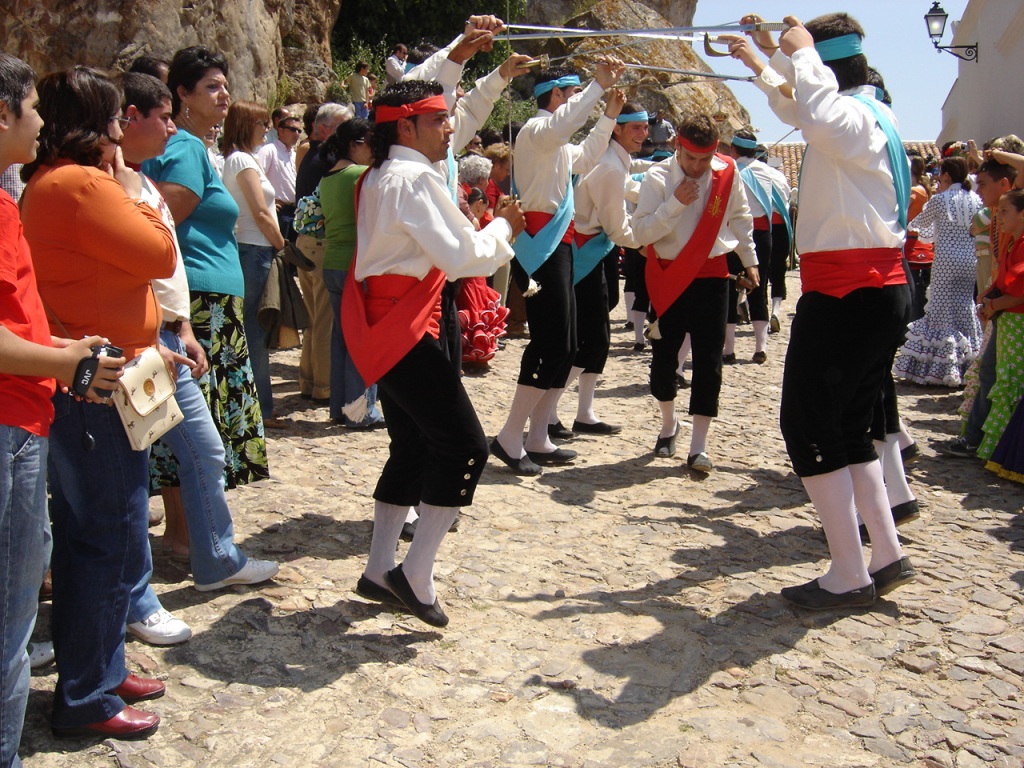
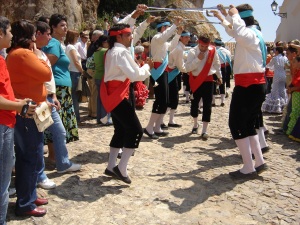 The streets were made of stone and like Obejo, the houses were uniformly painted white to deal with the hot sun of southern Spain. Tomas had an office on the second floor of the building, which had mosaic on the front with red trim. Tomas was excited to see me and he grabbed all the videos and pictures that he had of the dancing and we set off in search of a computer. The sound didn’t work on his, the picture stuttered on the other office computer. The other computers in the building were being used so we went to the library. One computer didn’t accept the disk, another wouldn’t start the program. Finally we used the librarian’s computer to watch a video of all sorts of dancing in the province where I learned there are many dances in the region that use swords, at least six of which I have been able to learn about the dance, history and traditions.
The streets were made of stone and like Obejo, the houses were uniformly painted white to deal with the hot sun of southern Spain. Tomas had an office on the second floor of the building, which had mosaic on the front with red trim. Tomas was excited to see me and he grabbed all the videos and pictures that he had of the dancing and we set off in search of a computer. The sound didn’t work on his, the picture stuttered on the other office computer. The other computers in the building were being used so we went to the library. One computer didn’t accept the disk, another wouldn’t start the program. Finally we used the librarian’s computer to watch a video of all sorts of dancing in the province where I learned there are many dances in the region that use swords, at least six of which I have been able to learn about the dance, history and traditions.

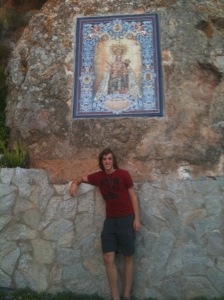 For the rest of the stuff we walked over to his house and watched the on the television. I was told the history of the dancing, both in the town and other parts of the province. The basic thing is that they are not performed on the patron saint (who no one really likes) but instead on the day of a different Virgin up in the mountains. I went up and visited the church where she (and her sister) are both represented. It is up at the top of a mountain where the above picture takes place. The festival is three days long and consists of lots of dancing, praying, feasting and going back and forth between the town and this church. Each day has a different set of events, but as far as I understand there is sword dancing pretty much throughout the whole thing. I should also mention that both here and in Obejo I was conducting all interactions entirely in spanish, so be proud of me, spanish teachers! The hill reminded me in many ways of Arrate. It was a church overlooking the main town and on clear days in both places you could see the ocean. Because of this, sailors would use the two churches as landmarks to navigate by!
For the rest of the stuff we walked over to his house and watched the on the television. I was told the history of the dancing, both in the town and other parts of the province. The basic thing is that they are not performed on the patron saint (who no one really likes) but instead on the day of a different Virgin up in the mountains. I went up and visited the church where she (and her sister) are both represented. It is up at the top of a mountain where the above picture takes place. The festival is three days long and consists of lots of dancing, praying, feasting and going back and forth between the town and this church. Each day has a different set of events, but as far as I understand there is sword dancing pretty much throughout the whole thing. I should also mention that both here and in Obejo I was conducting all interactions entirely in spanish, so be proud of me, spanish teachers! The hill reminded me in many ways of Arrate. It was a church overlooking the main town and on clear days in both places you could see the ocean. Because of this, sailors would use the two churches as landmarks to navigate by!
At one point during our conversations (I forget which day) Tomas says to me “And then after that dance, everyone rides their horse up to the top.” I pause him for a second thinking I have misheard, “Wait…Everyone rides Their horse?” Yes. Everyone (or at least every family) has a horse. My goodness!
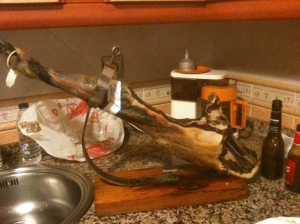 Afterwards we went Tomas’ house for dinner. I had a very interesting conversation with his wife and one of her friends about the differences in education systems in the US vs Spain. Another highlight of the evening was teaching his children and their friends how to play Egyptian War (Egyptian ratscrew, however you call it). I had found them playing a similar game that only included slaps, and they found my version much more interesting! They also have an obsession with cold cuts in spain, particularly ham. This is taken to the point where families have a holder for storing a huge leg of meat which they just slice of very thin strips when they want to serve it. Delicious, but slightly strange to see in the kitchen. The next day Tomas took me to go see an old abandoned mine in the mountains nearby.
Afterwards we went Tomas’ house for dinner. I had a very interesting conversation with his wife and one of her friends about the differences in education systems in the US vs Spain. Another highlight of the evening was teaching his children and their friends how to play Egyptian War (Egyptian ratscrew, however you call it). I had found them playing a similar game that only included slaps, and they found my version much more interesting! They also have an obsession with cold cuts in spain, particularly ham. This is taken to the point where families have a holder for storing a huge leg of meat which they just slice of very thin strips when they want to serve it. Delicious, but slightly strange to see in the kitchen. The next day Tomas took me to go see an old abandoned mine in the mountains nearby.

 The area had been famous for mining, with mostly british companies coming in in the early 20th century and building mining towns all around these sites to bring in workers. There are still villages that consist entirely of one design of house that were left over from these times. The brits also introduced footbal at this point, and we drove past one of the fields that was constructed by a british company in the 1920s. The mines themselves had filled up entirely with water and were rather beautiful. Tomas also somehow talked be into trying these things that looked like really tall acorns and turned out to be super bitter. He admitted that they weren’t ripe yet, but promised that they actually were quite tasty when they were!.
The area had been famous for mining, with mostly british companies coming in in the early 20th century and building mining towns all around these sites to bring in workers. There are still villages that consist entirely of one design of house that were left over from these times. The brits also introduced footbal at this point, and we drove past one of the fields that was constructed by a british company in the 1920s. The mines themselves had filled up entirely with water and were rather beautiful. Tomas also somehow talked be into trying these things that looked like really tall acorns and turned out to be super bitter. He admitted that they weren’t ripe yet, but promised that they actually were quite tasty when they were!.

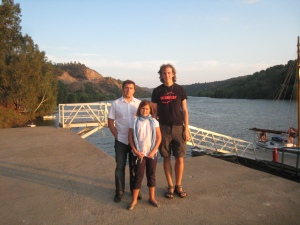 That evening we took a drive with his family to portugal, across the river dividing the countries and up to an old castle. We paused in the little town on the border to explore the docks and take some photos. This town was where the trains from the coal mines came to offload their freight into boats that would distribute it around the country and the world. As soon as we crossed into portugal, more things were in English than spanish, which was quite a strange feeling. Even at the restaurant that night, the menus were all in english and portugese, and so I was able to help translate for my hosts! At the top of the town was an old castle and church build 700 years ago!
That evening we took a drive with his family to portugal, across the river dividing the countries and up to an old castle. We paused in the little town on the border to explore the docks and take some photos. This town was where the trains from the coal mines came to offload their freight into boats that would distribute it around the country and the world. As soon as we crossed into portugal, more things were in English than spanish, which was quite a strange feeling. Even at the restaurant that night, the menus were all in english and portugese, and so I was able to help translate for my hosts! At the top of the town was an old castle and church build 700 years ago!
I really can’t thank Tomas and the government of Pueblo de Guzman enough for their help answering all my many sword dancing questions and for putting my up. People’s hospitality continues to amaze me! Goodnight for now!
 ALL DANCING PHOTOS: Credit to Tomas Borrero and Dancers in the Obejo Sword Dance Group
ALL DANCING PHOTOS: Credit to Tomas Borrero and Dancers in the Obejo Sword Dance Group
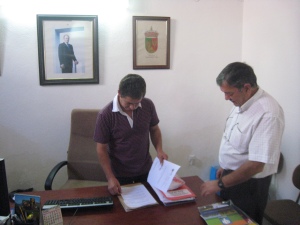

[…] partying. We were picked up by Tomás, the man from Puebla de Guzman from whom I had learned about sword dancing last year. He kindly drove us to the bus station in his town (since there were no buses until evening the […]